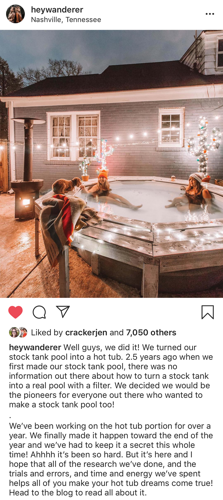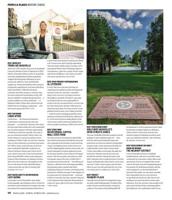Sponsored content is nothing new, really. Product placement has been around as long as Hollywood itself — the term “soap opera” comes from the fact that early radio dramas were often sponsored by manufacturers of cleaning products. And so it follows that the practice would make its way to social media and so-called Instagram influencers, who are paid for sponsored posts because of their reach.
In Nashville, there are quite a few high-profile Instagram accounts with follower counts in the tens of thousands. East Nashville profile Hey Wanderer (@heywanderer) — run by best friends Casey Freeman, 38, and Savannah McNeill, 30 — has north of 16,000 followers, with posts dating back to 2012. The two women, who met while working at Demos’ Restaurant downtown, say many really successful influencers were early adopters of the platform.
Hey Wanderer focuses on home decor, fashion, travel and DIY projects, and was born out of a blog called Hey Wanderer that Freeman and McNeill started around 2010, with a clothing brand of the same name after that. Almost immediately after starting the blog, Freeman and McNeill were approached to be paid for brand deals. Now McNeill works on the account full time, and Freeman works two days as a nurse in addition to running the account.

“We really started taking it seriously when we had a clothing brand,” Freeman says. “That’s when we started turning the account into what our followers wanted to see and paying attention to what they didn’t want to see. At that point, it became a real tool for us to get a brand out there, and to help sustain what we do with brand deals.”
Sponsored posts and brand deals can come about in a few different ways. Some companies offer free products in return for promotion — not a great deal for someone looking to make a living as an influencer. Many times, companies reach out directly to an account and ask to make a deal. There are also networks that mediate between influencers and brands and help connect people that might work well together.
Influencers can also apply for campaigns — where companies put out a call for accounts to submit an application and essentially say what they can offer the company. Occasionally an influencer will reach out to a brand they want to work with and end up with a deal, though that’s more rare.
Longstanding accounts have found ways to diversify. Hey Wanderer, for instance, is exploring creating content for other users, and they also teach an “Art of Instagram” course for people wanting to learn the trade. Some accounts sell pre-sets of what filters, saturation, contrast and focus they use on their photos — so followers can make their photos look like the accounts they like to follow.
The gig can look glamorous from the outside — take some photos, maybe travel, make beautiful dishes, post pictures and get paid for it. But dealing with clients can often mean you’re going back and forth on how a photo looks, where the product is placed, and maybe even your own appearance in the post.
“There’s a lot of freedom with most sponsored deals to say things the way you would say them in your own words, but sometimes it’s a little more rigid,” Freeman says. “But it’s contradictory when a brand wants to micromanage, because often that post will get less engagement, because people can tell when it’s not exactly how we would do it.”
Freeman and McNeill say the bottom price for a sponsored post is roughly a penny per follower — about $100 for every 10,000 followers. But the spectrum can be pretty wide. Some people make more than $1,000 per post, or more for a larger campaign with a big company.
“Often the amount of money you make and the size of the company you work with [corresponds] with the number of followers you have at any given moment,” says 33-year-old Laura Lea Bryant, who runs the Nashvilled-based Instagram account Laura Lea Balanced (@lauraleabalanced).

Laura Lea Bryant
Bryant is a trained chef who says her Instagram account is just one tool she uses to promote her books and recipes, which focus on easy, healthy meals for families. Laura Lea Balanced has 66,000 followers and started as an offshoot of her blog of the same name. But the account isn’t her main business — in additions to writing cookbooks, she teaches and participates in food partnerships with businesses in Nashville.
“There are plenty of people who create their business out of the Instagram — like, the goal is to make the account the business,” Bryant says. “But it’s not really the foundation of my business. My work has always been about food and recipes, and Instagram is a tool to promote that.”
Bryant says one thing that’s attractive to potential sponsors and brands is an Instagram engagement rate, which is measured by how many of an account’s followers go out and buy a product if the account posts about it.
“I have a high engagement rate, which is about 11 percent engagement,” Bryant says. “If I share a product, about 11 percent of my followers buy it. I have very loyal followers who came to me a natural way, so it never feels forced to me.”
She says most accounts have about a 2 percent engagement rate, which still looks pretty good to potential sponsors.
Bryant and the women who run Hey Wanderer agree that the downside to being an influencer is that you often have a lot of your personhood wrapped up in the account. Bryant recently had to close her direct messages, explaining that she couldn’t keep up with the constant influx.
“Not being able to get back to everybody, and give everyone the time and attention to everyone that wants it, it is really tough,” Bryant says.
The key is to not let any of it go to your head, and to try find a healthy way to interact with your audience.
“We don’t look to the followers as a way to soothe our souls,” McNeill says.









